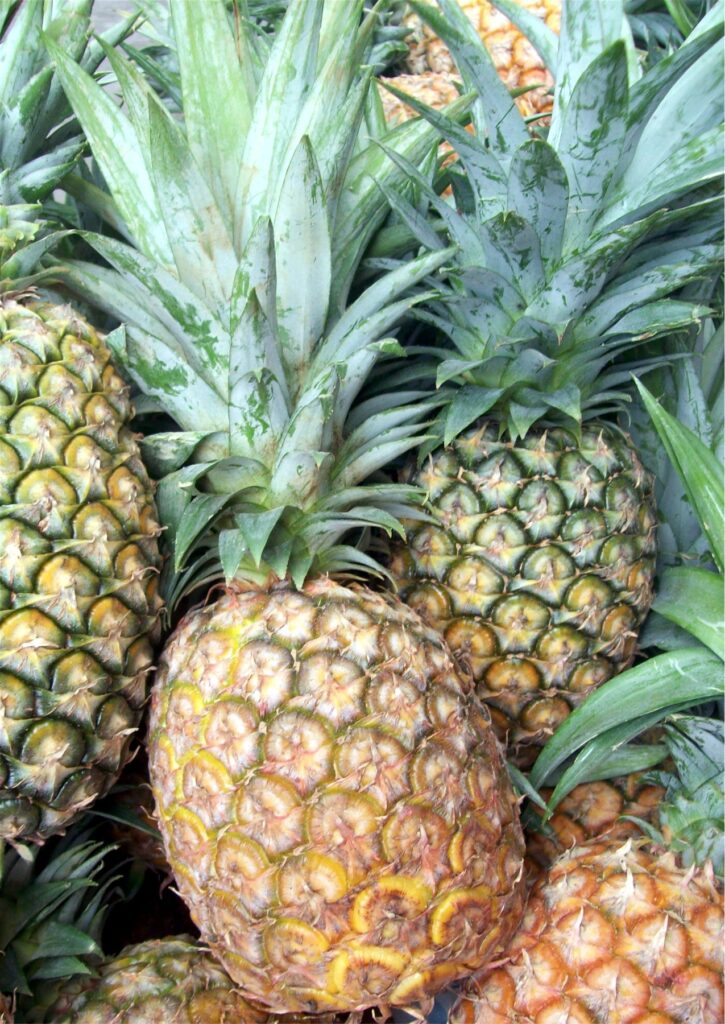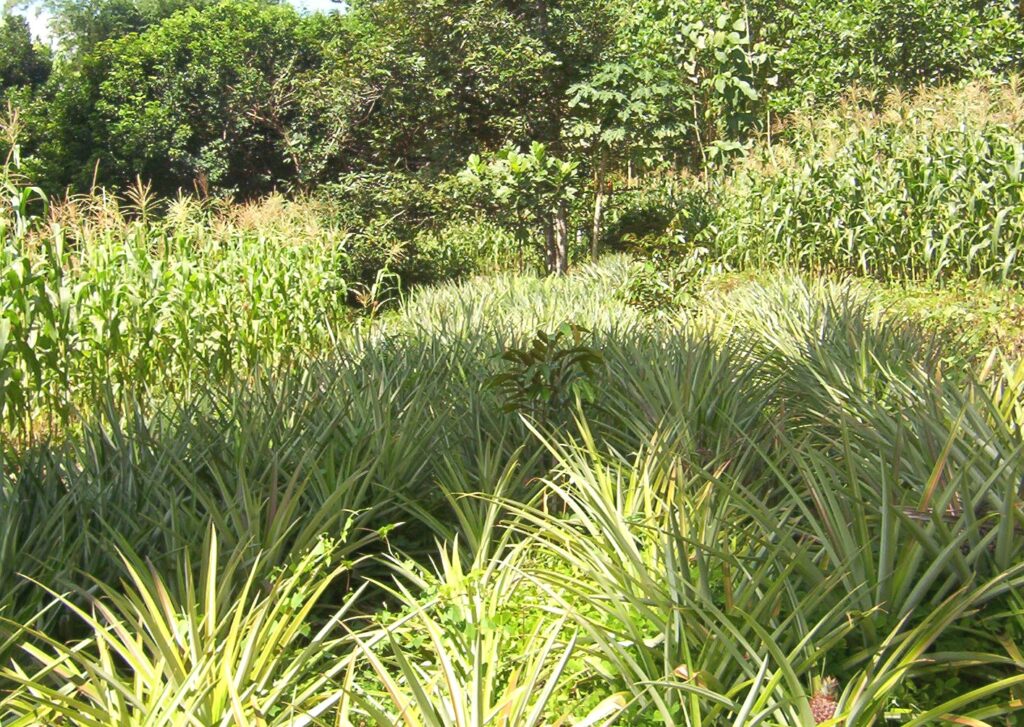Text and Photos by Henrylito D. Tacio
Smooth pineapple is one of the country’s major food exports, along with fresh banana and luscious mango. In fact, the Philippines is the second-largest exporter of pineapple in the world (Japan alone buys almost 80 percent of total pineapple exports).
But not too many Filipinos know that pineapple is not a native of the country. It is believed to have originated from Brazil, where tribal peoples have always regarded pineapple highly and have used it as a staple food and as an ingredient in some wines. When early explorers brought the pineapple back to Europe, its sweetness and unusual appearance made the fruit a symbol of royal privilege.
Being popular in Europe, the Spaniards (who carved pineapples over doorways) brought the fruit in the Philippines after the latter was rediscovered in 1521. Today, the Philippines, along with Brazil, Malaysia, Taiwan, Mexico, the Philippines, South Africa, and Puerto Rico, are the top producing countries in the world.
For years, Hawaii supplied 70% of the world’s canned pineapple and 85% of canned pineapple juice, but labor costs have shifted a large segment of the industry from Hawaii to the Philippines. In 1983, Dole transferred 75% of its operation to the country.
How pineapple got its name is an interesting story. When he came across pineapple in 1493 on the island of Guadeloupe, Christopher Columbus called it la piňa de las Indians (“the pine of the Indies”) because, as he later told Ferdinand and Isabella, they resembled “green pine cones, very sweet and delicious.” The odd name stuck, and pineapples are still called piňas in most Spanish-speaking countries. In fact, the word pineapple originally meant “pine cone” in England.
Aside from eating raw, pineapple is also added to fruit salad, pies, cakes, ice cream, yogurt, punches, and other desserts. Pineapple is an ingredient in most sweet and sour dishes and is used in many savory dishes.
Throughout all this history, the pineapple was valued strictly as a table delicacy. All but forgotten were the early explorers’ intriguing observations that Indians had used pineapple poultices to reduce inflammation in wounds and other skin injuries.

Pineapple 
Growing pineapple
Then, in 1891 an enzyme called bromelain was isolated from the flesh of the pineapple and was discovered to be proteolytic – that is, it breaks down protein. Hence it is a natural meat tenderizer (the pineapple rings atop a baked ham are not there just for the flavor) and digestive aid. It can also break down blood clots-proteins are what hold blood platelets together to form clots — and clean away the dead tissue left by burns, abscesses, ulcers, and various kinds of surgery. Bromelain also has proved effective in killing parasites such as worms.
Studies have shown that bromelain in pineapples can interfere with the preparation of some foods, such as jelly or other gelatin-based desserts. The bromelain breaks down in the canning process, thus canned pineapple can generally be used with gelatin.
Just a word of warning: Bromelain can be hazardous to someone suffering from certain protein deficiencies or disorders, such as Ehlers-Danlos syndrome. Pineapples should also not be consumed by those with hemophilia or by those with kidney or liver disease, as it may reduce the time taken to coagulate a consumer’s blood.
When unripe, the pineapple is not only inedible but poisonous, irritating the throat and acting as a drastic purgative. Excessive consumption of pineapple cores has caused the formation of fiber balls (bezoars) in the digestive tract.
Women who want to get pregnant should not eat pineapple. In some parts of the world, the flesh of very young fruits is deliberately ingested to achieve abortion (a little with honey on 3 successive mornings).
Despite such drawbacks, pineapple has a thousand medicinal uses. Florence Daniel, in her book Food Remedies, has named pineapple juice as the specific remedy for diphtheria. The sour, unripe fruit improves digestion, increases appetite, and relieves dyspepsia.
In Indian herbal medicine, pineapple is thought to act as a uterine tonic. The ripe fruit cools and soothes and is used to settle gas and reduce excessive gastric acid. Its significant fiber content makes it useful in constipation. The juice of the ripe fruit is both a digestive tonic and a diuretic. The leaves are considered to be useful in encouraging the onset of menstrual periods and easing painful ones.
Another benefit of eating pineapple is that it helps to build healthy bones. Pineapples are rich in manganese, a trace mineral that is needed for your body to build bone and connective tissues. The benefits of pineapple when you have a cold or cough are the same as the benefits of orange juice, as pineapple contains significant amounts of vitamin C.
There are several other uses of pineapple. In Africa, young, tender shoots are eaten in salads. The terminal bud or “cabbage” and the inflorescences are eaten raw or cooked. Young shoots, called hijos de pina, are sold on vegetable markets in Guatemala.
Pineapple crowns are sometimes fed to horses if not needed for planting. Final pineapple waste from the processing factories may be dehydrated as “bran” and fed to cattle, pigs, and chickens. Expendable plants from old fields can be processed as silage for maintaining cattle when other feed is scarce. The silage is low in protein and high in fiber and is best mixed with urea, molasses, and water to improve its nutritional value.
Meanwhile, pineapple leaves yield a strong, white, silky fiber. Chinese people in Kwantgung Province and on the island of Hainan weave the fiber into coarse textiles resembling grasscloth. In India, the thread is prized by shoemakers. In the Philippines, piña cloth is highly esteemed. In Taiwan, they also make coarse cloth for farmers’ underwear.
In recent years, there is a growing demand for it as a beverage. Crushed pineapple, juice, nectar, concentrate, marmalade, and other preserves are commercially prepared from the flesh remaining attached to the skin after the cutting and trimming of the central cylinder. All residual parts cores, skin, and fruit ends are crushed and given a first pressing for the juice to be canned as such or prepared as syrup used to fill the cans of fruit, or is utilized in confectionery and beverages, or converted into powdered pineapple extract, which has various roles in the food industry.
Chlorophyll from the skin and ends imparts a greenish hue that must be eliminated, and the juice must be used within 20 hours as it deteriorates quickly. A second pressing yields “skin juice,” which can be made into vinegar or mixed with molasses for fermentation and distillation of alcohol.
By the way, the pineapple fruit with crown intact is often used as a decoration, and there are variegated forms of the plant universally grown for their showiness indoors or out. Since 1963, thousands of potted, ethylene treated pineapple plants with fruits have been shipped annually from southern Florida to northern cities in the United States as indoor ornamentals.
Pineapple, anyone?

